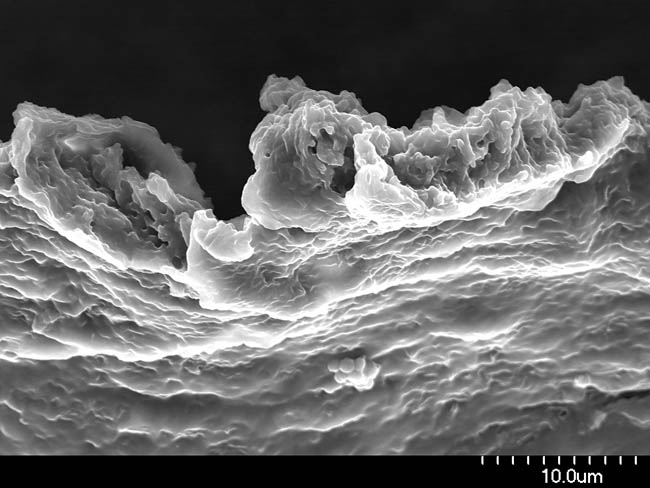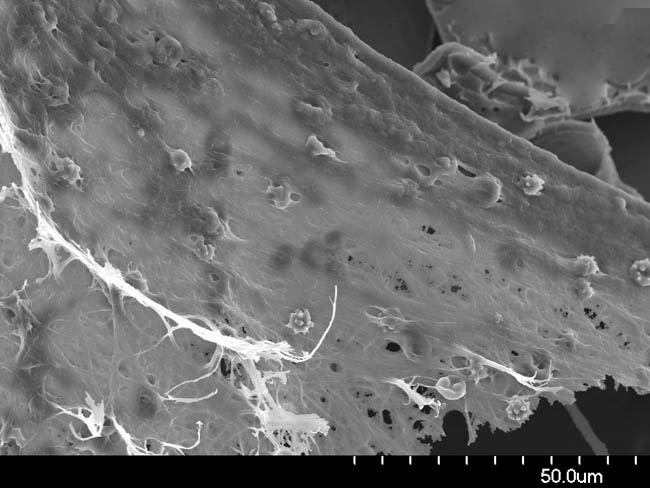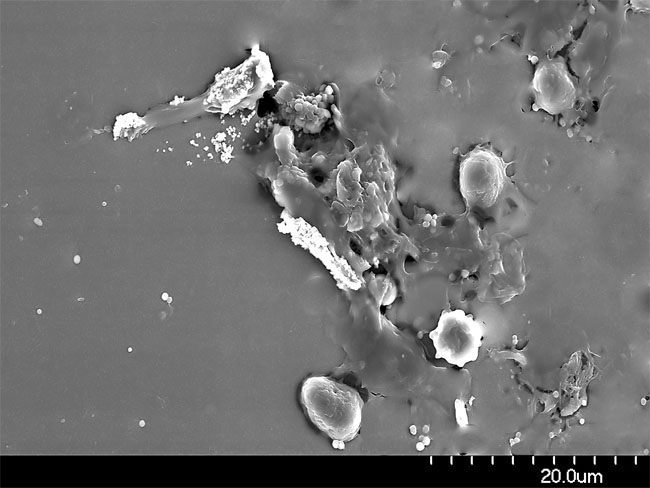|

SEM Micrograph of a Biofilm formed by
Bacterial Colony on Silicon Substrate
Biofilm is a generic term
used to describe a sludge like material that develops in association
with organic materials. Biofilms result from a variety of sources, and
negatively impact a number of industrial and medical applications. a
Biofilm is composed of a densely packed group of microorganisms. A key
property of biofilms is that individual microorganisms are bound
together by a polymeric substance excreted by the microorganisms. This
polymeric substance forms an adhesive matrix that holds the biofilm
together, allows it to attach to surfaces, and can serve as an
encapsulation which protects the colony forming the biofilm. This
protective encapsulation is believed to play a role in some
antibiotic-resistant infections.
The polymeric substance excreted
by the microorganisms is known as an extracellular polymeric substance
(EPS). It is also commonly called an extracellular adhesive matrix.
A key aspect of biofilms is a
complex interaction among the constituent mircoorganisms. A biofilm
forms when individual microorganisms cease to exhibit individual, free
floating behavior, and begin to associate with each other, and a
surface, and begin to act in concert with each other. A biofilm grows by
both simple cell division, and by new free floating microorganisms
associating with the developing biofilm.
Biofilms usually develop on solid surfaces immersed
in a liquid.
Biofilm formation causes problems
in a variety of industrial and medical applications. In macro
applications, biofilms can lead to a phenomenon called biofouling, in
which a biofilm grows to the point that it interferes with the intended
operation of a device. An example of biofouling can be found in the
shipping industry. Micro organisms like bacteria or algae can form a
microfilm on the hull of a ship. This biofilm can serve as an attractive
substrate for the attachment of macro organisms like seaweed or
barnacles. This macro coating fouls the hull, and can impact efficiency
of the vessel.
Biofouling is a common problem in
water treatment plants and filtration applications where biofilms can
cause clogging in filters and pipes.

SEM of Biofilm Which Encapsulated
Biomedical Prototype
Biofilms can be a particular
problem in the development of implantable medical devices. The image
above shows a dense biofilm that had encapsulated a medical prototype.
Individual white blood cells can be on the surface of the biofilm.
There are a number of mechanisms which can lead to
biofilm formation on implanted devices. A simple example is that
leucocytes can "find" the implant, interpret the surface as a foreign
material, and trigger the formation of a dense fibrin mat around the
implant. This encapsulation can yield the device non-functional.
Development of successful implants requires careful selection of
materials, and in particular surface properties, such that the device
will not be encapsulated by the body.
Surfaces in medical implants can also be an
attractive place for bacteria to attach and form a biofilm, and cause
an infection. More complex
biofilms can also form involving complex interactions
between bacteria, leucocytes attaching to fight the bacteria, and then a
complex biofilm developing both by the body, and the bacteria.

Complex Biofilm
The photograph above shows the
initial formation of a complex biofilm. A colony of
bacteria is starting to form in several areas on the surface of the
device. The bacteria are the very small spherical structures. In some
areas, the bacteria are clustering together, and an emerging adhesive
matrix is developing around the groups of bacteria. Making this a very
interesting picture is the fact that a number of much larger Leucocytes
(White Blood Cells) have detected the bacterial infection, and have also
attached to the surface, and appear to be forming their own biofilm in
response to the bacteria. |


